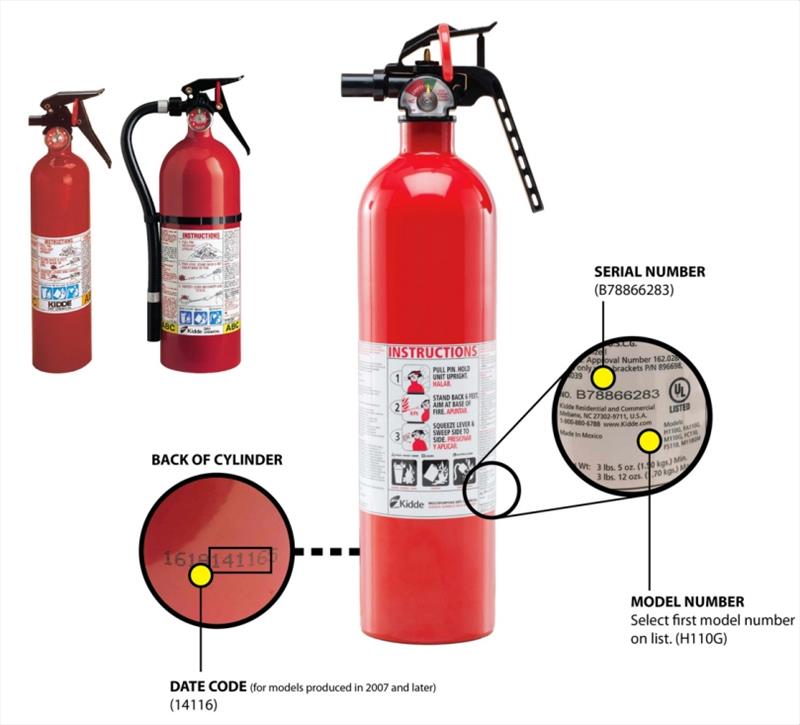
BoatUS Spring Commissioning Checklist
by Scott Croft 16 Mar 2019 13:50 UTC

As part of spring commissioning, boaters should check their boat's fire extinguishers to see if they were included in a 2017 product safety recall of more than 40 million Kidde fire extinguishers © Scott Croft
With boatyards, backyards, marinas, and clubs now coming to life, spring commissioning time has arrived.
Boat Owners Association of The United States (BoatUS) has a Spring Commissioning Checklist to help boaters start the season right:
Before You Launch
1. Inspect and replace hose clamps as necessary. Double-clamp fuel lines and exhaust hoses with marine-rated stainless steel hose clamps. Keep seacocks closed when you are away from the boat.
2. Inspect all hoses for stiffness, rot, leaks and cracking, and replace any that are faulty. Make sure they fit snugly.
3. Inspect prop(s) for dings, pitting and distortion. Make sure cotter pins are secure.
4. Grip the prop (on inboard drive systems) and try moving the shaft up and down and side to side. If it's loose and can be wiggled, the cutless bearing may need to be replaced.
5. Check the rudderstock to ensure it hasn't been bent. Operate the wheel or tiller to ensure the steering works correctly.
6. Inspect the hull for blisters, distortions and stress cracks.
7. Make sure your engine intake sea strainer (if equipped) is not cracked or bent from ice and is free of corrosion, clean and properly secured.
8. With inboards, check the engine shaft and rudder stuffing boxes for correct adjustment. A stuffing box should leak no more than two drops each minute when the prop shaft is turning.
9. Inspect and lubricate seacocks.
10. Use a garden hose to check for deck leaks at ports and hatches. Renew caulk or gaskets as necessary.
11. Inspect the bilge pump and float switch to make sure they're both working properly.
12. Check stove and remote LPG tanks for loose fittings and leaking hoses.
13. Inspect dock and anchor lines for chafe and wear.
14. If equipped, ensure that the stern drain plug is installed.
15. After the boat is launched, be sure to check all thru-hulls for leaks.
Engines and Fuel Systems
1. Inspect fuel lines, including fill and vent hoses, for softness, brittleness or cracking. Check all joints for leaks, and make sure all lines are well supported with noncombustible clips or straps with smooth edges.
2. Inspect fuel tanks, fuel pumps and filters for leaks. Ensure portable tanks and lines are completely drained of stale fuel before filling with fresh fuel. Clean or replace fuel filters and/or fuel-water separators.
3. Every few years, remove and inspect exhaust manifolds for corrosion (for inboard-powered and inboard/outboard boats).
4. Charge battery.
5. Clean and tighten electrical connections, especially both ends of battery cables. Use a wire brush to clean battery terminals, and top up cells with distilled water (if applicable).
6. Inspect the bilge blower hose for leaks and run the blower to confirm correct operation.
Engine Outdrives and Outboards
1. Inspect rubber outdrive bellows for cracked, dried and/or deteriorated spots (look especially in the folds) and replace if suspect.
2. Check power steering and power trim oil levels.
3. Replace anodes that are more than half wasted away.
4. Inspect the outer jacket of control cables. Cracks or swelling indicate corrosion and mean that the cable must be replaced.
5. Inspect lower unit oil level and top up as necessary.
Sailboat Rigging
1. Inspect swage fittings for cracks and heavy rust (some discoloration is acceptable). Inspect wire halyards and running backstays for "fishhooks" and rust.
2. Remove tape on turnbuckles and lubricate threads, preferably with Teflon. Replace old tape with fresh tape.
3. If you suspect the core around a chainplate is damp, remove the chainplate to inspect and make repairs.
Trailers
1. Inspect tire treads and sidewalls for cracks or lack of tread and replace as necessary. Check air pressure; don't forget the spare.
2. Inspect wheel bearings and repack as necessary.
3. Test all lights and replace any broken bulbs or lenses.
4. Inspect winch to make sure it's working properly. Inspect hitch chains.
5. Inspect trailer frame for rust. Sand and paint to prevent further deterioration.
6. Inspect brakes and brake fluid reservoir.
Safety
1. Check expiration dates on flares.
2. Inspect fire extinguishers. Replace if over 12 years old or if age is unknown. More than 40 million Kidde extinguishers with plastic handles were recalled on Nov. 2, 2017.
3. Ensure you have properly sized and wearable life jackets in good condition for each passenger, including kids. Check inflatable life jacket cylinders and dissolvable "pill" bobbins in auto-inflating models.
4. Test smoke, carbon monoxide, fume and bilge alarms.
5. Check running lights for operation and spare bulb inventory.
6. Update paper charts and chartplotter software.
7. Replenish first-aid kit items that may have been used last season.
8. Check the operation of VHF radio(s) and that the MMSI number is correctly programmed in. (BoatU.S. members can obtain a free MMSI number at BoatUS.com/MMSI.)
9. Get a free vessel safety check from the U.S. Coast Guard Auxiliary or U.S. Power Squadrons. Find out more at SafetySeal.net.
For the Dock
1. Check both ends of the shore power cable connections for burns, which indicate the cable and/or boat's shore power inlet or the dock's receptacle must be replaced.
2. Test ground-fault protection on your boat and private dock, and know how to prevent Electric Shock Drowning.
The Paperwork
1. Make sure your boat registration is up to date. Don't forget your trailer tags.
2. Review your boat insurance policy and update coverage if needed. BoatUS provides free quotes at BoatUS.com/Insurance. Provide a copy to your marina or club.
3. Ensure your BoatUS Membership is in good standing. Login to BoatUS.com/Account to check your Membership status or join at BoatUS.com/Join.
4. Download the free BoatUS App to make it easy to summon on-water assistance and speed response times.